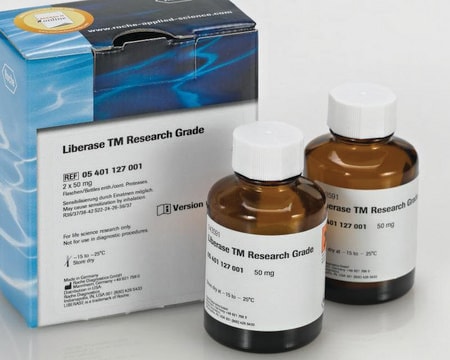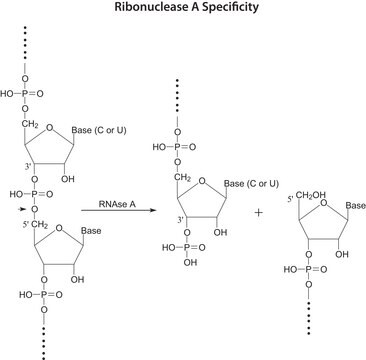Kluczowe dokumenty
DN25
Deoxyribonuclease I from bovine pancreas
lyophilized powder, Protein ≥85 %, ≥400 Kunitz units/mg protein
Synonim(y):
Deoxyribonuclease, DNase I, Deoxyribonucleate 5′-oligonucleotido-hydrolase
About This Item
Polecane produkty
pochodzenie biologiczne
bovine pancreas
Formularz
lyophilized powder
aktywność właściwa
≥400 Kunitz units/mg protein
masa cząsteczkowa
~31 kDa
skład
Protein, ≥85%
metody
DNA extraction: suitable
rozpuszczalność
0.15 M NaCl: soluble 5.0 mg/mL, hazy
przydatność
suitable for molecular biology
Zastosowanie
diagnostic assay manufacturing
diagnostic assay manufacturing
obecność zanieczyszczeń
RNase ≤0.02%
Warunki transportu
wet ice
temp. przechowywania
−20°C
Szukasz podobnych produktów? Odwiedź Przewodnik dotyczący porównywania produktów
Powiązane kategorie
Opis ogólny
- Our DNase I Digests double str and single stranded DNA into oligo and mononucleotides.
- Bovine pancreatic DNase exists as four isozymes, having isoelectric points for A, B, C and D: 5.22, 4.96, 5.06 and 4.78.3. The predominant form is A, with smaller amounts of B and C, and only minor amount of D.
- DNase I structure resembles the structure of to exonuclease III. It includes two central ß sheets. Each β sheet is composed of six β-strands. This complex of β sheets is surrounded by extensive loop and α-helical regions. This enzyme shares structural similarity to exonuclease III.[1]
Zastosowanie
- Decreases viscosity providing better yields by removing DNA in primary cell isolation:
- Incorporating labelled bases into DNA: DNA nick
- Radioactive labelling
- Bioprocessing applications: DNA removal
- Eliminating genomic DNA from RNA preparations before RT-PCR
- In vitro transcription
- Nick translation
- DNase footprinting
- Actin regulation of actin polymerization in cells, and cell apoptosis
- UV crosslinking of proteins to nucleic acids
- DNase play a role in the regulation of actin polymerization in cells and is involved in apoptosis process [1]
Działania biochem./fizjol.
Cechy i korzyści
Definicja jednostki
Postać fizyczna
Uwaga dotycząca przygotowania
Komentarz do analizy
Inhibitor
Hasło ostrzegawcze
Danger
Zwroty wskazujące rodzaj zagrożenia
Zwroty wskazujące środki ostrożności
Klasyfikacja zagrożeń
Resp. Sens. 1
Kod klasy składowania
11 - Combustible Solids
Klasa zagrożenia wodnego (WGK)
WGK 3
Temperatura zapłonu (°F)
Not applicable
Temperatura zapłonu (°C)
Not applicable
Środki ochrony indywidualnej
Eyeshields, Gloves, type N95 (US)
Wybierz jedną z najnowszych wersji:
Masz już ten produkt?
Dokumenty związane z niedawno zakupionymi produktami zostały zamieszczone w Bibliotece dokumentów.
Klienci oglądali również te produkty
Produkty
To standardize a procedure for the enzymatic assay of Deoxyribonuclease I at Sigma-Aldrich St. Louis.
Protokoły
Standaryzacja procedury enzymatycznego oznaczania deoksyrybonukleazy I.
Nasz zespół naukowców ma doświadczenie we wszystkich obszarach badań, w tym w naukach przyrodniczych, materiałoznawstwie, syntezie chemicznej, chromatografii, analityce i wielu innych dziedzinach.
Skontaktuj się z zespołem ds. pomocy technicznej










